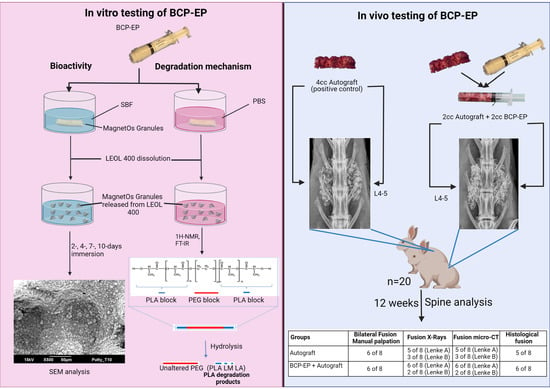Physico-Chemical Characteristics and Posterolateral Fusion Performance of Biphasic Calcium Phosphate with Submicron Needle-Shaped Surface Topography Combined with a Novel Polymer Binder
Abstract
:1. Introduction
2. Materials and Methods
2.1. Preparation of BCP-EP
2.2. Characterization of BCP-EP
2.3. In Vitro Degradation of BCP-EP
2.4. Bioactivity Testing of BCP-EP in SBF
2.5. Twelve-Week Implantation Study of BCP-EP/ABG in a Rabbit Posterolateral Fusion Model
2.5.1. Preparation of Graft Materials
2.5.2. Animal Model and Surgical Procedure
2.5.3. Radiographical Fusion by X-rays and Micro-CT
2.5.4. Fusion by Manual Palpation Testing
2.5.5. Histological Fusion and Histomorphometry
- Decalcified histology: Decalcification of the spines was conducted in 10% formic acid at room temperature for 3 to 4 days. The spine was sectioned in four blocks of ~3 mm prior to immersion in paraffin. Three sections of 5 microns were obtained from each paraffin block using a Leica microtome (Leica Microsystems Pty Ltd., North Ryde, NSW, Australia) and were subsequently stained with hematoxylin and eosin (H&E). An Olympus light microscope (Olympus, Japan) was used to analyze the stained sections in a blinded manner. The qualitative assessment of tissue response, signs of graft resorption, new bone formation, the presence of inflammatory cells or tissue necrosis, development of the marrow space, and bony fusion across the two transverse processes were all included in the examination. On the spine of a Rallis’ Tetrachrome [30], staining was used to observe bone maturation on decalcified paraffin histology.
- Undecalcified histology: The spines were dried with ethanol series prior to embedding in PMMA. Then, 15-micron-thick sections of the sagittal plane obtained through a Leica SP1600 saw microtome (Leica Microsystems Pty Ltd., North Ryde, NSW, Australia) were stained with methylene blue (1% in 0.1 M borax buffer, pH 8.5) and basic fuchsin (0.3% in water). All PMMA blocks were cut into three sections, with a space of 2 mm between each, to analyze the complete fusion mass. Images at low magnification were finally used for histomorphometrical analysis.
- Histomorphometry: For a quantitative analysis, three images at low magnification (1.25×, 1 mm scale bar) from the two transverse processes and the fusion center were used. An investigator blinded to the study groups used a polygon approach to establish the region-of-interest (ROI), and graft material or bone mineralized tissue was assessed by pixel color and morphological evaluation using established techniques [6]. Each fusion area was calculated as a ROI percentage, and a mean value was calculated based on the three PMMA sections.
- Distant organ analysis: The heart, liver, lungs, kidney, spleen, lymph nodes, pancreas, adrenal gland, thyroid gland, pituitary gland, and ovaries were harvested. A portion of each tissue was similarly processed for paraffin histology, H&E staining, and routine histopathological review for signs of any adverse reactions.
2.5.6. Statistical Analysis
3. Results
3.1. Characterization BCP-EP
3.2. In Vitro Degradation of BCP-EP

| Immersion Time | Pristine | Baseline | 1 h | 1 Day | 14 Days |
|---|---|---|---|---|---|
| Average Mn (Da) | 1702 | 1708 | 1715 | 1685 | 1591 |
| LA/PLA ratio | 0.33 | 0.33 | 0.33 | 0.50 | 0.80 |
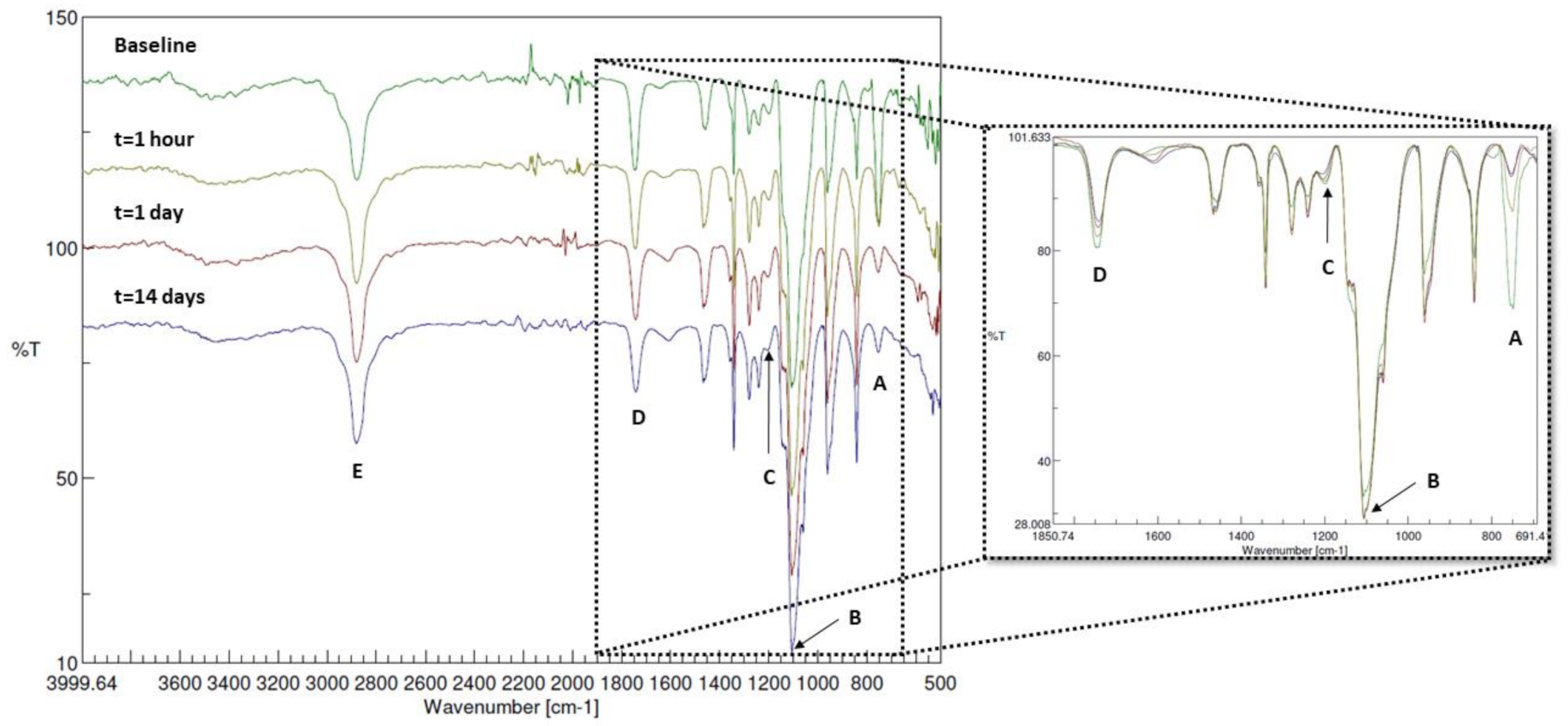
3.3. Bioactivity
3.4. Twelve-Week Implantation Study of BCP-EP/ABG in a Rabbit Posterolateral Fusion Model
3.4.1. Radiographical Fusion by X-ray and Micro-CT
3.4.2. Fusion by Manual Palpation Testing
3.4.3. Histological Fusion and Histomorphometry
4. Discussion
5. Conclusions
Author Contributions
Funding
Institutional Review Board Statement
Informed Consent Statement
Data Availability Statement
Acknowledgments
Conflicts of Interest
References
- Hsu, W.K.; Nickoli, M.S.; Wang, J.C.; Lieberman, J.R.; An, H.S.; Yoon, S.T.; Youssef, J.A.; Brodke, D.S.; McCullough, C.M. Improving the Clinical Evidence of Bone Graft Substitute Technology in Lumbar Spine Surgery. Glob. Spine J. 2012, 2, 239–248. [Google Scholar] [CrossRef] [Green Version]
- Mabud, T.; Norden, J.; Veeravagu, A.; Swinney, C.; Cole, T.; McCutcheon, B.A.; Ratliff, J. Complications, Readmissions, and Revisions for Spine Procedures Performed by Orthopedic Surgeons Versus Neurosurgeons: A Retrospective, Longitudinal Study. Clin. Spine Surg. 2017, 30, E1376–E1381. [Google Scholar] [CrossRef]
- Morris, M.T.; Tarpada, S.P.; Cho, W. Correction to: Bone graft materials for posterolateral fusion made simple: A systematic review. Eur. Spine J. 2021, 30, 2410–2411. [Google Scholar] [CrossRef] [PubMed]
- Einsatz von Knochenersatzmaterialien bei Fusionen der Wirbelsäule. Available online: https://www.springermedizin.de/einsatz-von-knochenersatzmaterialien-bei-fusionen-der-wirbelsaeu/8111784 (accessed on 21 January 2022).
- van Dijk, L.A.; Duan, R.; Luo, X.; Barbieri, D.; Pelletier, M.; Christou, C.; Rosenberg, A.J.W.; Yuan, H.; Barrere-de Groot, F.; Walsh, W.R. Biphasic calcium phosphate with submicron surface topography in an Ovine model of instrumented posterolateral spinal fusion. JOR Spine. 2018, e1039. [Google Scholar] [CrossRef] [PubMed] [Green Version]
- van Dijk, L.A.; Barbieri, D.; Barrère-de Groot, F.; Yuan, H.; Oliver, R.; Christou, C.; Walsh, W.R.; de Bruijn, J.D. Efficacy of a synthetic calcium phosphate with submicron surface topography as autograft extender in lapine posterolateral spinal fusion. J. Biomed. Mater. Res. B Appl. Biomater. 2019, 107, 2080–2090. [Google Scholar] [CrossRef] [PubMed]
- Duan, R.; A Van Dijk, L.; Barbieri, D.; De Groot, F.; Yuan, H.; De Bruijn, J.D. Accelerated bone formation by biphasic calcium phosphate with a novel sub-micron surface topography. Eur. Cells Mater. 2019, 37, 60–73. [Google Scholar] [CrossRef] [PubMed]
- van Dijk, L.A.; Barrère-de Groot, F.; Rosenberg, A.J.W.; Pelletier, M.; Christou, C.; de Bruijn, J.D.; Walsh, W.R. MagnetOs, Vitoss, and Novabone in a Multi-endpoint Study of Posterolateral Fusion. Clin. Spine Surg. 2020, 33, E276–E287. [Google Scholar] [CrossRef]
- van Dijk, L.A.; de Groot, F.; Yuan, H.; Campion, C.; Patel, A.; Poelstra, K.; de Bruijn, J.D. From benchtop to clinic: A translational analysis of the immune response to submicron topography and its relevance to bone healing. Eur. Cells Mater. 2021, 40, 756–773. [Google Scholar] [CrossRef]
- Wynn, T.A.; Vannella, K.M. Macrophages in Tissue Repair, Regeneration, and Fibrosis. Immunity 2016, 44, 450–462. [Google Scholar] [CrossRef] [Green Version]
- Hachim, D.; Lopresti, S.T.; Yates, C.C.; Brown, B.N. Shifts in macrophage phenotype at the biomaterial interface via IL-4 eluting coatings are associated with improved implant integration. Biomaterials 2017, 112, 95–107. [Google Scholar] [CrossRef] [Green Version]
- Mahon, O.R.; Browe, D.; Gonzalez-Fernandez, T.; Pitacco, P.; Whelan, I.T.; Von Euw, S.; Hobbs, C.; Nicolosi, V.; Cunningham, K.T.; Mills, K.; et al. Nano-particle mediated M2 macrophage polarization enhances bone formation and MSC osteogenesis in an IL-10 dependent manner. Biomaterials 2020, 239, 119833. [Google Scholar] [CrossRef]
- van Dijk, L.A.; Utomo, L.; Yuan, H.; Barrère-de Groot, F.; Gawlitta, D.; Rosenberg, A.W.J.P.; DeBruijn, J. Calcium phosphates with submicron topography enhance human macrophage M2 polarization in vitro. Manuscript in preparation. Spine J. 2020, 20, S25. [Google Scholar] [CrossRef]
- Nouri-Goushki, M.; Isaakidou, A.; Eijkel, B.I.M.; Minneboo, M.; Liu, Q.; Boukany, P.E.; Mirzaali, M.J.; Fratila-Apachitei, L.E.; Zadpoor, A.A. 3D printed submicron patterns orchestrate the response of macrophages. Nanoscale 2021, 13, 14304–14315. [Google Scholar] [CrossRef]
- Vassey, M.J.; Figueredo, G.P.; Scurr, D.J.; Vasilevich, A.S.; Vermeulen, S.; Carlier, A.; Luckett, J.; Beijer, N.R.M.; Williams, P.; Winkler, D.A.; et al. Immune Modulation by Design: Using Topography to Control Human Monocyte Attachment and Macrophage Differentiation. Adv. Sci. 2020, 7, 1903392. [Google Scholar] [CrossRef]
- Sjöström, T.; Dalby, M.J.; Hart, A.; Tare, R.; Oreffo, R.O.C.; Su, B. Fabrication of pillar-like titania nanostructures on titanium and their interactions with human skeletal stem cells. Acta Biomater. 2009, 5, 1433–1441. [Google Scholar] [CrossRef]
- Lovmand, J.; Justesen, J.; Foss, M.; Lauridsen, R.H.; Lovmand, M.; Modin, C.; Besenbacher, F.; Pedersen, F.S.; Duch, M. The use of combinatorial topographical libraries for the screening of enhanced osteogenic expression and mineralization. Biomaterials 2009, 30, 2015–2022. [Google Scholar] [CrossRef]
- Nouri-Goushki, M.; Angeloni, L.; Modaresifar, K.; Minneboo, M.; Boukany, P.E.; Mirzaali, M.J.; Ghatkesar, M.K.; Fratila-Apachitei, L.E.; Zadpoor, A.A. 3D-Printed Submicron Patterns Reveal the Interrelation between Cell Adhesion, Cell Mechanics, and Osteogenesis. ACS Appl. Mater. Interfaces 2021, 13, 33767–33781. [Google Scholar] [CrossRef]
- Bohner, M. Design of ceramic-based cements and putties for bone graft substitution. Eur. Cells Mater. 2010, 20, 1–12. [Google Scholar] [CrossRef]
- Barbieri, D.; Yuan, H.; De Groot, F.; Walsh, W.R.; De Bruijn, J.D. Influence of different polymeric gels on the ectopic bone forming ability of an osteoinductive biphasic calcium phosphate ceramic. Acta Biomater. 2011, 7, 2007–2014. [Google Scholar] [CrossRef]
- Davison, N.; Yuan, H.; de Bruijn, J.D.; Groot, F.B.-D. In vivo performance of microstructured calcium phosphate formulated in novel water-free carriers. Acta Biomater. 2012, 8, 2759–2769. [Google Scholar] [CrossRef]
- Fellah, B.H.; Weiss, P.; Gauthier, O.; Rouillon, T.; Pilet, P.; Daculsi, G.; Layrolle, P. Bone repair using a new injectable self-crosslinkable bone substitute. J. Orthop. Res. 2006, 24, 628–635. [Google Scholar] [CrossRef]
- International Organization for Standardization. Implants for Surgery: Homopolymers, Copolymers and Blends on Poly(lactide) - in Vitro Degradation Testing; ISO 13781-2017.
- Kokubo, T.; Takadama, H. Simulated Body fluid (SBF) as a Standard tool to test the bioactivity of implants. In Handbook of Biomineralization: Biological Aspects and Structure Formation; Wiley: Hoboken, NJ, USA, 2008; Volume 3, pp. 97–109. [Google Scholar] [CrossRef]
- Campion, C.R.; Ball, S.L.; Clarke, D.L.; Hing, K.A. Microstructure and chemistry affects apatite nucleation on calcium phosphate bone graft substitutes. J. Mater. Sci. Mater. Electron. 2012, 24, 597–610. [Google Scholar] [CrossRef]
- Boden, S.D.; Schimandle, J.H.; Hutton, W.C.; Chen, M.I. The Use of an Osteoinductive Growth Factor for Lumbar Spinal Fusion. Spine 1995, 20, 2626–2632. [Google Scholar] [CrossRef]
- Fredericks, D.; Petersen, E.B.; Watson, N.; Grosland, N.; Gibson-Corley, K.; Smucker, J. Comparison of Two Synthetic Bone Graft Products in a Rabbit Posterolateral Fusion Model. Iowa Orthop. J. 2016, 36, 167–173. [Google Scholar]
- Crowley, J.D.; Oliver, R.A.; Dan, M.J.; Wills, D.J.; Rawlinson, J.W.; Crasto, R.A. Single level posterolateral lumbar fusion in a New Zealand White rabbit (Oryctolagus cuniculus) model: Surgical anatomy, operative technique, autograft fusion rates, and perioperative care. JOR Spine. 2020, 4. [Google Scholar] [CrossRef]
- Lenke, L.G.; Bridwell, K.H.; Bullis, D.; Betz, R.R.; Baldus, C.; Schoenecker, P.L. Results of In Situ Fusion for Isthmic Spondylolisthesis. J. Spinal Disord. 1992, 5, 433–442. [Google Scholar] [CrossRef]
- Rallis, Z.; Watkins, G. Modified tetrachrome staining method for osteoid and defectively mineralized bone in paraffin sections. Biotech. Histochem. 1992, 67, 339–345. [Google Scholar] [CrossRef]
- Heald, C.R.; Stolnik, S.; Kujawinski, K.S.; De Matteis, C.; Garnett, M.C.; Illum, L.; Davis, S.S.; Purkiss, S.C.; Barlow, R.J.; Gellert, P.R. Poly(lactic acid)−Poly(ethylene oxide) (PLA−PEG) Nanoparticles: NMR Studies of the Central Solidlike PLA Core and the Liquid PEG Corona. Langmuir 2002, 18, 3669–3675. [Google Scholar] [CrossRef]
- Zhao, H.; Liu, Z.; Park, S.-H.; Kim, S.-H.; Kim, J.-H.; Piao, L. Preparation and Characterization of PEG/PLA Multiblock and Triblock Copolymer. Bull. Korean Chem. Soc. 2012, 33, 1638–1642. [Google Scholar] [CrossRef] [Green Version]
- Cohn, D.; Younes, H. Biodegradable PEO/PLA block copolymers. J. Biomed. Mater. Res. 1988, 22, 993–1009. [Google Scholar] [CrossRef] [PubMed]
- Vrandečić, N.S.; Erceg, M.; Jakić, M.; Klarić, I. Kinetic analysis of thermal degradation of poly(ethylene glycol) and poly(ethylene oxide)s of different molecular weight. Thermochim. Acta 2010, 498, 71–80. [Google Scholar] [CrossRef]
- Kister, G.; Cassanas, G.; Vert, M. Effects of morphology, conformation and configuration on the IR and Raman spectra of various poly(lactic acid)s. Polymer 1998, 39, 267–273. [Google Scholar] [CrossRef]
- Pucic, I.; Jurkin, T. Crystallization of g-irradiated poly(ethylene oxide). Radiat. Phys. Chem. 2007, 76, 1318–1323. [Google Scholar] [CrossRef]
- Garric, X.; Guillaume, O.; Dabboue, H.; Vert, M.; Molès, J.-P. Potential of a PLA–PEO–PLA-Based Scaffold for Skin Tissue Engineering: In Vitro Evaluation. J. Biomater. Sci. Polym. Ed. 2012, 23, 1687–1700. [Google Scholar] [CrossRef]
- Dorati, R.; Colonna, C.; Serra, M.; Genta, I.; Modena, T.; Pavanetto, F. gamma-Irradiation of PEGd, lPLA and PEG-PLGA multiblock copolymers. I. Effect of irradiation doses. AAPS PharmSciTech. 2008, 9, 718–725. [Google Scholar] [CrossRef]
- Cohn, D.; Younes, H. Compositional and structural analysis of PELA biodegradable block copolymers degrading under in vitro conditions. Biomaterials 1989, 10, 466–474. [Google Scholar] [CrossRef]
- Gorrasi, G.; Pantani, R. Hydrolysis and Biodegradation of Poly (lactic acid). In Synthesis, Structure and Properties of Poly (lactic acid). Advances in Polymer Science; Springer: Cham, Switzerland, 2017. [Google Scholar] [CrossRef]
- Elsawy, M.; Kim, K.-H.; Park, J.-W.; Deep, A. Hydrolytic degradation of polylactic acid (PLA) and its composites. Renew. Sustain. Energy Rev. 2017, 79, 1346–1352. [Google Scholar] [CrossRef]
- Seifter, J.L.; Chang, H.-Y. Extracellular Acid-Base Balance and Ion Transport Between Body Fluid Compartments. Physiology 2017, 32, 367–379. [Google Scholar] [CrossRef]
- da Silva, D.; Kaduri, M.; Poley, M.; Adir, O.; Krinsky, N.; Shainsky-Roitman, J. Biocompatibility, biodegradation and excretion of polylactic acid (PLA) in medical implants and theranostic systems. Chem. Eng. J. 2018, 340, 9–14. [Google Scholar] [CrossRef]
- Casalini, T.; Rossi, F.; Castrovinci, A.; Perale, G. A Perspective on Polylactic Acid-Based Polymers Use for Nanoparticles Synthesis and Applications. Front. Bioeng. Biotechnol. 2019, 7, 259. [Google Scholar] [CrossRef]
- Fruijtier-Pölloth, C. Safety assessment on polyethylene glycols (PEGs) and their derivatives as used in cosmetic products. Toxicology 2005, 214, 1–38. [Google Scholar] [CrossRef] [PubMed]
- Webster, R.; Didier, E.; Harris, P.; Siegel, N.; Stadler, J.; Tilbury, L.; Smith, D. PEGylated Proteins: Evaluation of Their Safety in the Absence of Definitive Metabolism Studies. Drug Metab. Dispos. 2006, 35, 9–16. [Google Scholar] [CrossRef] [PubMed] [Green Version]
- Stefaniak, K.; Masek, A. Green Copolymers Based on Poly(Lactic Acid)—Short Review. Materials 2021, 14, 5254. [Google Scholar] [CrossRef] [PubMed]
- Walsh, W.R.; Oliver, R.A.; Gage, G.; Yu, Y.; Bell, D.; Bellemore, J.; Adkisson, H.D. Application of Resorbable Poly(Lactide-co-Glycolide) with Entangled Hyaluronic Acid as an Autograft Extender for Posterolateral Intertransverse Lumbar Fusion in Rabbits. Tissue Eng. Part A 2011, 17, 213–220. [Google Scholar] [CrossRef] [Green Version]
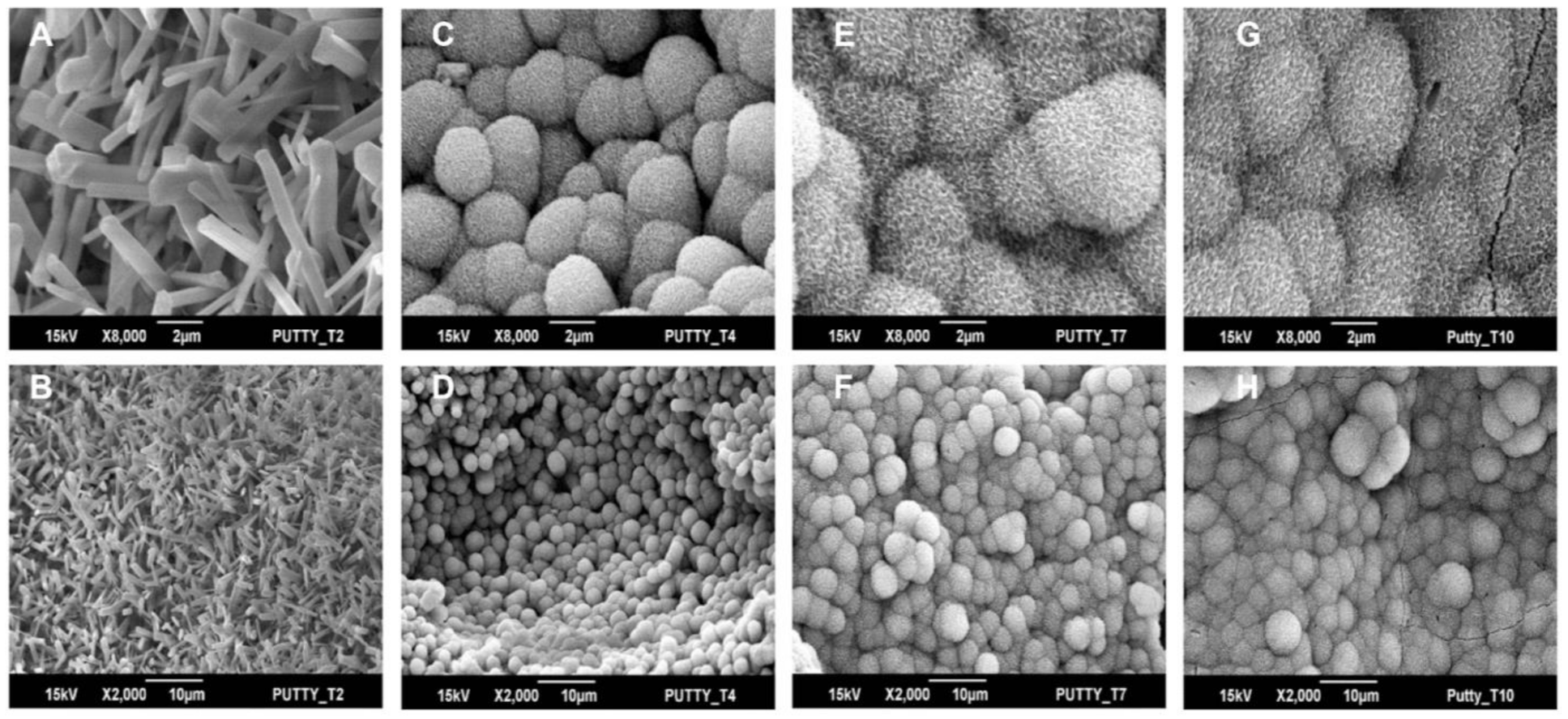
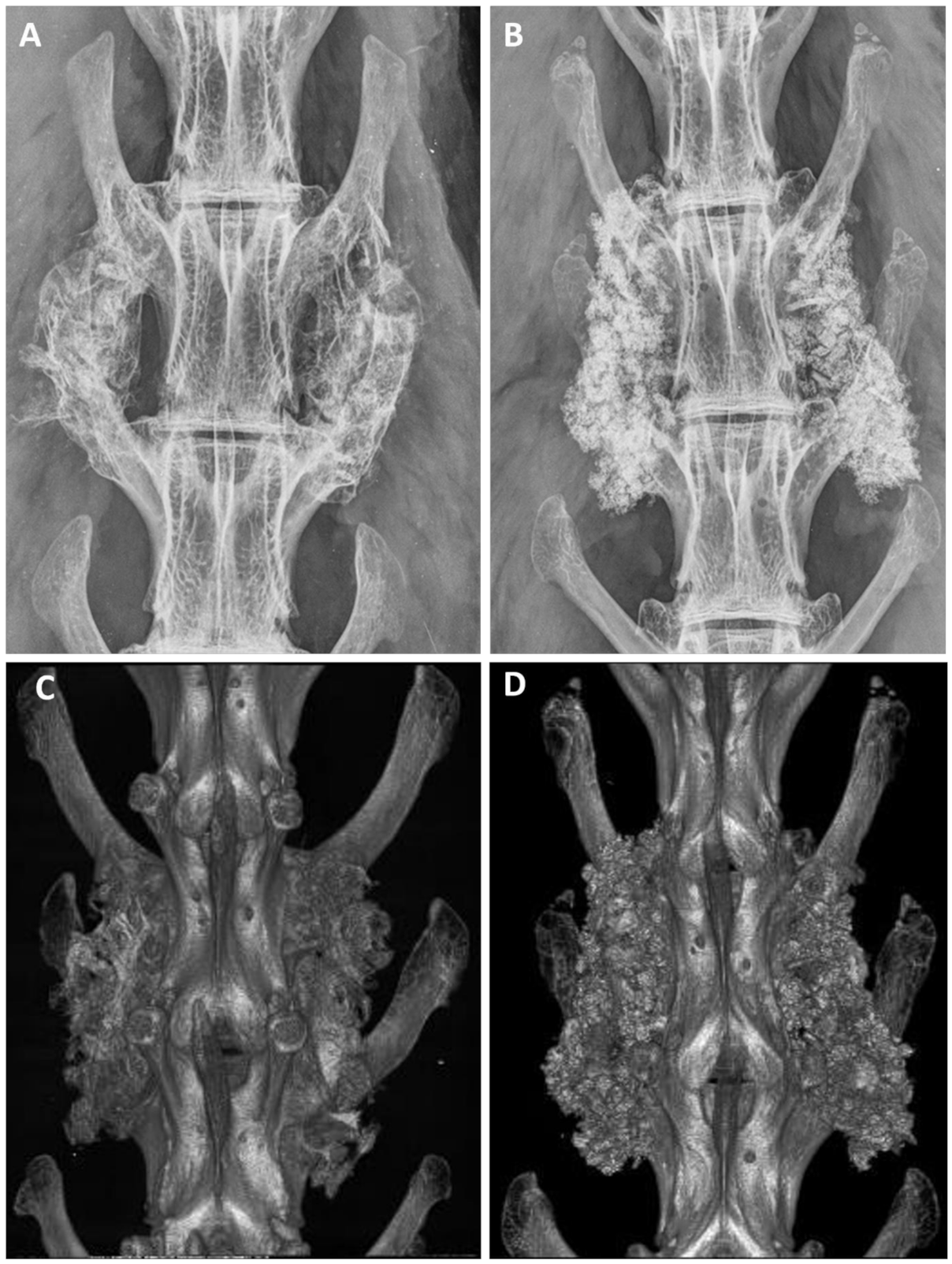

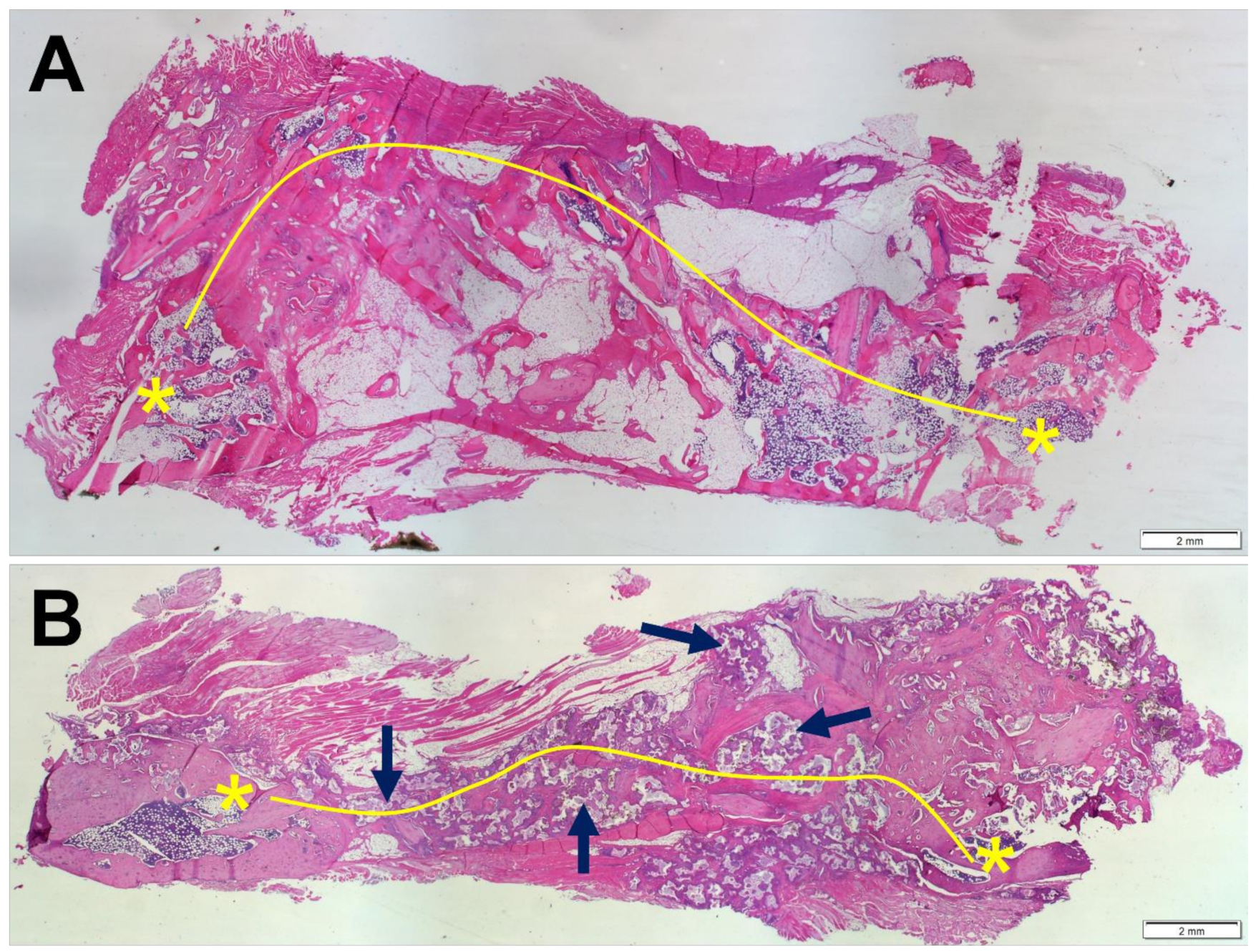
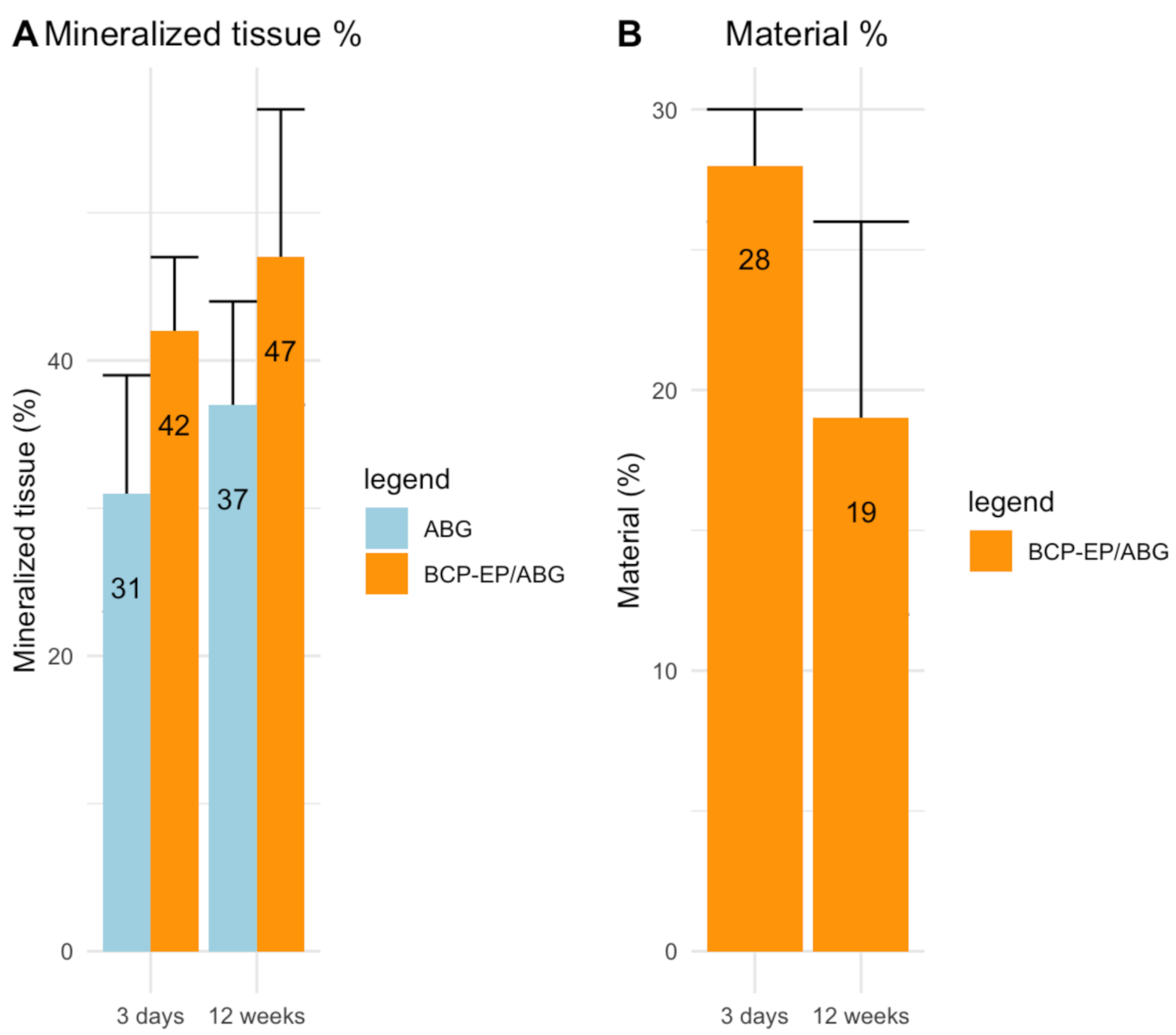
| Groups | Bilateral Fusion Manual Palpation | Fusion X-rays | Micro-CT Fusion | Histological Fusion |
|---|---|---|---|---|
| ABG | 6 of 8 | 5 of 8 (Lenke A) 3 of 8 (Lenke B) | 5 of 8 (Lenke A) 3 of 8 (Lenke B) | 5 of 8 |
| BCP-EP/ABG | 6 of 8 | 6 of 8 (Lenke A) 2 of 8 (Lenke B) | 6 of 8 (Lenke A) 2 of 8 (Lenke B) | 6 of 8 |
Publisher’s Note: MDPI stays neutral with regard to jurisdictional claims in published maps and institutional affiliations. |
© 2022 by the authors. Licensee MDPI, Basel, Switzerland. This article is an open access article distributed under the terms and conditions of the Creative Commons Attribution (CC BY) license (https://creativecommons.org/licenses/by/4.0/).
Share and Cite
Belluomo, R.; Arriola-Alvarez, I.; Kucko, N.W.; Walsh, W.R.; de Bruijn, J.D.; Oliver, R.A.; Wills, D.; Crowley, J.; Wang, T.; Barrère-de Groot, F. Physico-Chemical Characteristics and Posterolateral Fusion Performance of Biphasic Calcium Phosphate with Submicron Needle-Shaped Surface Topography Combined with a Novel Polymer Binder. Materials 2022, 15, 1346. https://doi.org/10.3390/ma15041346
Belluomo R, Arriola-Alvarez I, Kucko NW, Walsh WR, de Bruijn JD, Oliver RA, Wills D, Crowley J, Wang T, Barrère-de Groot F. Physico-Chemical Characteristics and Posterolateral Fusion Performance of Biphasic Calcium Phosphate with Submicron Needle-Shaped Surface Topography Combined with a Novel Polymer Binder. Materials. 2022; 15(4):1346. https://doi.org/10.3390/ma15041346
Chicago/Turabian StyleBelluomo, Ruggero, Inazio Arriola-Alvarez, Nathan W. Kucko, William R. Walsh, Joost D. de Bruijn, Rema A. Oliver, Dan Wills, James Crowley, Tian Wang, and Florence Barrère-de Groot. 2022. "Physico-Chemical Characteristics and Posterolateral Fusion Performance of Biphasic Calcium Phosphate with Submicron Needle-Shaped Surface Topography Combined with a Novel Polymer Binder" Materials 15, no. 4: 1346. https://doi.org/10.3390/ma15041346





